NEED HELP ASAP
Concentration and Reaction Rate
In this task, you will determine how the conc...

NEED HELP ASAP
Concentration and Reaction Rate
In this task, you will determine how the concentrations of the reactants affect the reaction rate, or how quickly a reaction takes place. Before you begin this task, read these lab safety guidelines. If you need a refresher on using a graduated cylinder and an electronic balance, watch the videos about measuring volume and measuring mass.
Estimated time to complete: 90 minutes
If you’re using an Edmentum lab kit, remove the electronic balance, graduated cylinder, thermometer, and safety goggles. These materials are italicized in the following equipment list. Then gather the additional items shown in the list. If you’re not using an Edmentum lab kit, alternatives are suggested in parentheses. If you do not have access to these materials, please check with your teacher for help.
You’ll need these materials:
graduated cylinder (may also use a 1-tablespoon measure)
electronic balance, precise to at least 0.1 gram, with weighing boat (may also use a
1
4
-teaspoon measure)
thermometer, readable from 0°C to 100°C (32°F to 212°F)
safety goggles
3
4
cup (180 milliliters) vinegar
1 tablespoon (18 grams) baking soda
water
stove, hot plate, or microwave oven (for heating water)
container appropriate for heating water
beaker, flask, or cup
spoon or stirring rod
stopwatch
Stay safe! Be careful when heating water or handling hot water to avoid burns. Be sure to wear safety goggles while performing the experiment.
Part A
In this task, you’ll observe a chemical reaction between baking soda and vinegar in water. Write a hypothesis to predict the relationship between the concentrations of the reactants and the rate of the reaction.
Part B
Next, you’ll test your hypothesis by examining the reaction times of vinegar and baking soda in boiling water using four different concentrations of the reactants. You’ll vary the concentrations by using
1
2
tablespoon (7.5 milliliters), 1 tablespoon (15 milliliters),
1
1
2
tablespoons (22.5 milliliters), and 2 tablespoons (30 milliliters) of water. Note that you will use the same amounts of vinegar and baking soda for each trial.
Gather all the materials, and proceed with these steps:
Boil at least 1 cup (240 milliliters) of water on a stove, on a hot plate, or in a microwave oven.
Measure and record the actual temperature of the water.
Measure the required amount of boiling water into the cup.
Add
1
4
teaspoon (1.5 grams) baking soda to the water, and stir until it is dissolved. The resulting solution will be clear.
Measure out 1 tablespoon (15 milliliters) of vinegar, but do not pour it into the cup yet.
Very quickly, do all of the following:
a. Pour the measured vinegar into the cup.
b. Start the stopwatch.
c. Stir or carefully swirl the substances in the cup.
The chemical reaction will produce bubbles. You’ll be able to see the bubbles and hear them pop. Watch and listen for when the reaction stops. When it looks and sounds like it has finished, stop the stopwatch.
Record the reaction time in the data table.
Discard the solution down the drain, and rinse the cup.
Repeat this procedure, doing three trials at each concentration. Record the average temperature and reaction time for each set of the three trials. Read this math review for a refresher on finding averages.
Part C
Question
Draw a graph of the average reaction time (variable y) versus the amount of water added (variable x) using your data from part B.
Part D
Explain how the reaction rate compared to the concentration of the vinegar and baking soda solution. Revisit your hypothesis in part A, and explain how it compares with your experimental results.
Part E
Study the trend of the graph from part C. What would the reaction time be if 3 tablespoons (45 milliliters) of water had been used? Express your answer in units of seconds.
Part F
Why is it a good idea to perform three trials at each concentration? How would you modify the experiment to produce more reliable results?
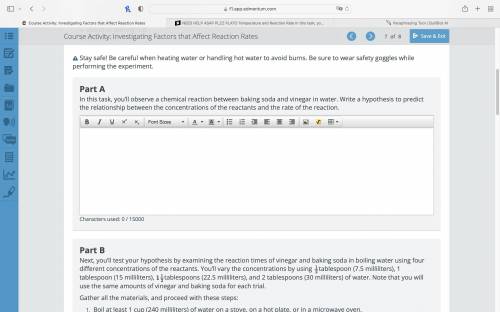
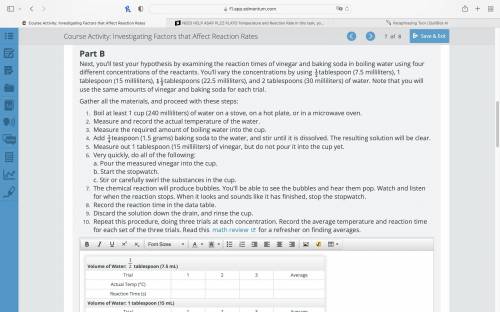
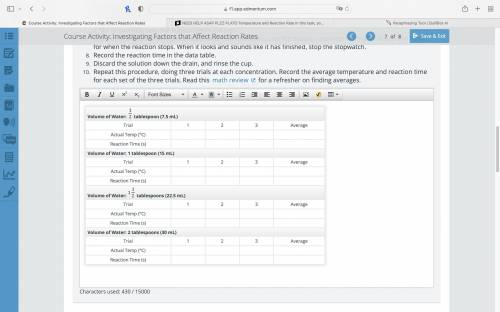
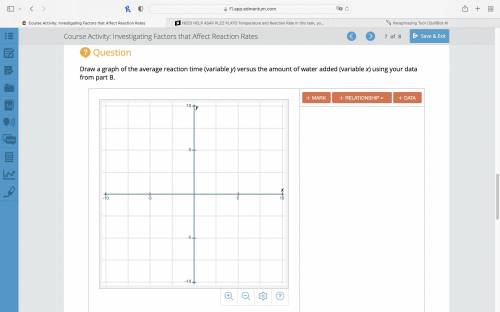
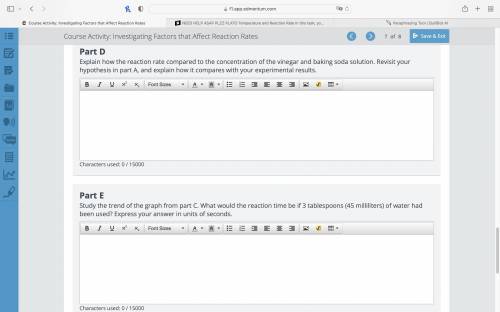

Answers: 2


Another question on Chemistry

Chemistry, 21.06.2019 18:30
A6.10 m nacl can be made by adding [x]g of nacl to a container and making the volume of water up to the 1.00 l line
Answers: 1

Chemistry, 22.06.2019 10:00
Miner's coal distributors does not mine coal itself, nor does it even store or handle the coal. instead, miner's solicits orders for low sulfur coal from other firms, then purchases the required amount from suppliers and directs them to ship the coal to its customers. what is miner's
Answers: 1

Chemistry, 22.06.2019 17:10
Increasing the substrate concentration in an enzymatic reaction could overcome which of the following? a) the need for a coenzymeb) allosteric inhibitionc) competitive inhibitiond) insufficient cofactors
Answers: 1

Chemistry, 23.06.2019 07:30
If you try to move a piano and are unable to move it, did you perform any work in the scientific sense of the word? yes or no?
Answers: 1
You know the right answer?
Questions


Geography, 03.06.2021 20:00


English, 03.06.2021 20:00

Mathematics, 03.06.2021 20:00

Mathematics, 03.06.2021 20:00

Mathematics, 03.06.2021 20:00


Chemistry, 03.06.2021 20:00

Mathematics, 03.06.2021 20:00

Mathematics, 03.06.2021 20:00


History, 03.06.2021 20:00

History, 03.06.2021 20:00



Mathematics, 03.06.2021 20:00

Mathematics, 03.06.2021 20:00




